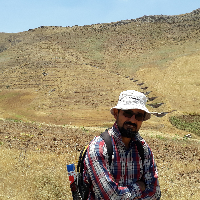Evaluation and Quantification of Ecosystem Services in Wheat (Triticum aestivum L.) Agroecosystem
Ecosystem services are usually divided into four categories: (a) provision services, (b) regulating services, (C) cultural services and (d) supporting services. Ecosystem services are managed in agroecosystems primarily for food production. But, agricultural ecosystems provide provision, regulating and cultural services for human society. These services respond strongly to human socio-economic needs. Quantifying the various services and functions of agroecosystems is one of the most important effective strategies in order to increase attention pay to these services. Therefore, the purpose of this study was evaluation and quantification of ecosystem services in wheat (Triticum aestivum L.) agroecosystems of Dasht-e-Naz, Sari.
This experiment was performed as an unbalanced completely design in wheat agroecosystems of Dasht-e-Naz, Sari (Mazandaran province), during 2019-2020. In this study, 9 wheat plots with 4 cultivars including Tirgan, Ehsan, Collector and N-92-9 were surveyed and monitored. In this study, some ecosystem services such as insect and weed biodiversity (using Shannon-Weiner, Simpson, Margalf, Uniformity and Menhinick indices), soil microbial respiration, carbon sequestration, organic matter, abundance of earthworms, grain yield, protein content oxygen production, and soil protection (by the stability of aggregates) were evaluated and quantified. Soil samples were taken from a depth of 0-30 cm before wheat planting in November 2019 and after harvest in June 2020 for assessment of rate of microbial respiration, organic matter and carbon sequestration. Also, oxygen production was estimated based on net primary production. Sampling of yield and plant biodiversity was harvested based on W pattern and with quadrate 0.5 × 0.5 m2. All samples were moved to the crop research laboratory of Gorgan University of Agricultural Sciences and Natural Resources and the plant flora was determined by genus and species names.
The results showed that crop management and performance of intensive agricultural system were effective on providing many services of ecosystems in wheat fields of Dasht-e-Naz, Sari. These services are influenced by several factors such as cultivar type, crop rotation, tillage, etc. The results showed that the effect of different cultivars was significant on grain yield and protein percentage. The highest percentage of grain protein as a provision service was obtained from Ehsan cultivar (12.15%) and the lowest content was obtained about 11.42% from N-92-9 cultivar. The highest wheat grain yield and oxygen production were calculated from plots under Collector cultivar. In additional, the highest amount of carbon sequestration (2.33 ton/ha) and microbial respiration rate in before planting and after harvest (76.46 and 38.52 mg CO2 per kg of soil per day, respectively) belonged to plot 15. Also, it was determined that plot 15 was better than other plots from soil protection service view based on the diameter mean weight index (MWD) and the geometric mean diameter index (GMD). In this research, three beneficial insects (biodiversity assessment) were observed such as Coccinella septempunctata Linnaeus and Aphidius matricariae, and Chrysoperla carnea. The highest values of Shannon-Weiner and uniformity indices of weeds were as 2.63 and 0.82 in plots 23 and 15, respectively. Furthermore, Shannon-Weiner and uniformity indices of insect communities were obtained as 2.07 and 0.94 from plot 22, respectively.
Generally, carbon sequestration, organic matter, microbial respiration, earthworm abundance, aggregate stability index, average weight diameter (MWD) and geometric mean diameter index (GMD) were better in plots 14 and 15 under wheat cultivation than other plots. The results of this study showed that crop management and implementation of intensive agricultural system were effective in providing many ecosystem services in wheat fields in Dasht-e Naz region of Sari. So that, these services were affected by several factors such as cultivar, crop rotation and tillage methods.
Acknowledgment
The authors gratefully acknowledge the financial support of Gorgan University of Agricultural Sciences and Natural Resources and Dr. Hamid Sakinin for his help.
- حق عضویت دریافتی صرف حمایت از نشریات عضو و نگهداری، تکمیل و توسعه مگیران میشود.
- پرداخت حق اشتراک و دانلود مقالات اجازه بازنشر آن در سایر رسانههای چاپی و دیجیتال را به کاربر نمیدهد.






